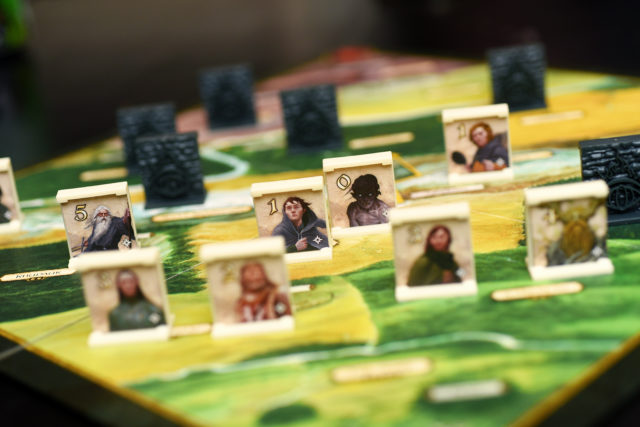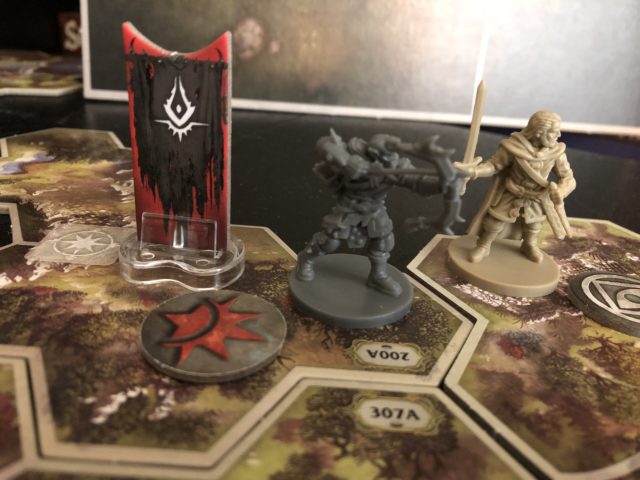The folks at fortyseven communications (all lower-case) kindly sent me Steam keys for the recently-fully-launched Lord of the Rings Adventure Card Game. I’ll be reviewing it in full next week (the tl;dr is I think it’s really good overall if you want a digital experience), but you know me. I always have to delve into the History of Things. In this case that meant researching and writing a whole other column on the tabletop history of Lord of the Rings-themed games. You’re welcome, Internet.

By my estimate there are roughly 60 LotR games in the BGG database. (I did it so you don’t have to.) That includes knockoffs like Lord of the Rings Chess, Lord of the Rings Backgammon (!), and at least two versions of Lord of the Rings Monopoly. No surprise that it is one of the best-served IP’s out there. Arguably, D&D and all its fantasy RPG and tabletop spawn draw spirit and inspiration from Tolkien’s work. (But that’s a whole other column.)
One piece of evidence for this is that, although the books were published in 1954-5, the first modern tabletop adaptation of LotR did not appear until 1978, after D&D had burst onto the scene; furthermore, it was a Milton Bradley tie-in with Ralph Bakshi’s legendary animated movie (itself a beneficiary of the resurgence of interest in swords and sorcery). The game wasn’t a good adaptation, being a very unthematic roll-and-move race to get your character to cast their One Ring (of which there were now…several?) into Mount Doom. Well, at least the board had hexagonal spaces, there’s something for you grognards.

It took another 22 years and the birth of the Eurogame movement for the first worthy LotR game to appear, designed by none other than The Good Doctor himself, Reiner Knizia. Actually he designed at least three of them. The one to seek out is Lord of the Rings (2000), a thematic and mechanic masterpiece in my opinion, still holding its own almost twenty years later. It’s fully co-operative (at least until you get the Sauron expansion), beautiful to look at, and endlessly replayable. Confusingly, in 2003 Knizia released another co-op Lord of the Rings with very different mechanics and pitched at a much younger audience.

Then, just to gild the lily, Knizia also designed Lord of the Rings: Confrontation (2003) to answer the question: what if Stratego was set in Middle Earth and designed by a master craftsman arguably at the height of his powers? Clearly, Knizia was in a bit of a Tolkien fugue in the early aughts.
Naturally there was also a LotR CCG–or a TCG, strictly speaking. Published by Decipher, who designed a bunch of TCG’s in the late 1990’s and early 2000’s, it was not a straight M:tG clone and it still has many adherents. There’s always at least one online implementation going; right now you can try Gemp. Still, thematically I find it questionable, with each player’s deck representing a rival fellowship adventuring through nine sites and trying to be the first make it out alive.
2004 saw the release of War of the Ring, also published by Fantasy Flight, who have clearly benefited the most from their LotR license. It remains one of the most popular epic “dudes on a map” games out there–and like others in that genre, it hardly ever gets played because it takes a huge table and several hours to play. Still, it remains in print and has no peer in terms of looking at the Big Picture, from a military strategy p.o.v., of Tolkien’s trilogy.
Soon after War of the Ring was published, the Peter Jackson movies came out, and a ton of new games came out. Most of them were published by WizKids and Pressman, while the literary rights were still held by the canny folks at FF. These movie tie-ins were as a rule pretty pedestrian affairs, glomming onto all the popular tabletop mechanics of the era: deckbuilders, dicebaggers, and tactical minis–not forgetting the usual roll-and-move crap. Probably my “favorite” of these was Lord of the Rings: Nazgul from 2012, which felt like it had been rethemed from something else, because it was a semi-co-op which turned the Nazgul from terrifying relentless hunters to scheming backbiting office-climbers.
But there was also at least one nugget hidden in the dross. Middle Earth Quest (2009) was a Fantasy Flight project designed by Corey Konieczka, Christian T. Peterson, and Tim Uren, so it had a lot going for it. The game was set in the time between Bilbo’s and Frodo’s adventures, which allowed the designers to pit a Sauron player with multiple maleficent plots against a ragtag bunch of misfits who weren’t quite Fellowship material. It’s an epic game with many decks and things to keep track of.

I should also give a shout out to Fantasy Flight’s newest spin on the franchise: 2019’s LotR: Journeys in Middle Earth, the latest in their “app-as-GM” series which started with 2012’s Descent 2E and 2014’s Star Wars: Imperial Assault. Only one mini-expansion has come out since the base game dropped earlier this year, and it’s an interesting system with lots of potential–if you’re ok being dependent on technology which will eventually age out.
Anyway. I want to swing back to 2011 and LotR: The Card Game, the fourth in FF’s series of money-spinners: the Living Card Game©️ (yes, it’s trademarked) series which began with Call of Cthulhu: TCG in 2008. FF touted LCG’s as a win-win situation for players: no more pay-to-win! No more boosters! What they didn’t say was that it was still going to be bloody expensive to keep up with the meta even if everyone was getting the same cards with every expansion, because you needed to buy (at least) two copies of the base game to have enough copies of rarer cards and expansions came fast and furious and cost what seemed at the time was a ludicrous amount for what was essentially a few dozen new cards.
Unlike the first three LCG’s, LotR:TCG was–is–co-operative and meant for only one or two players. The object is to work through a Quest Deck, exploring locations, and drawing events and baddies from a separate Encounters Deck. You build your personal deck around up to three heroes with one or two Spheres of Influence (not unlike land types in M:tG). The progress of Evil is tracked by a quantity called Threat, which increases a bit every turn–more if you trigger certain events–and if it reaches a certain threshold you lose.
I bought, played, and enjoyed LotR:TCG when it came out, sucker as I am for anything involving deckbuilding which doesn’t require me to buy boosters. After a while, though, I found it a bit dry and abstract. Although the card art is excellent, the lack of a map left me detached, like I was playing a sort of campaign-driven tower-defence game because every turn it was the baddies coming at me and exploration was a matter of dropping tokens on a card. Plus, it was bloody hard to win. Which is good, don’t get me wrong, but spending two hours only to die on the cusp of winning a scenario and faced with the idea of resetting to the beginning made me want to just put the game away. In the end, I ended selling it off. Despite my lukewarm enthusiasm, it went on to sell scads of copies.
Then, at the end of 2017, FF Interactive and Asmodée digital announced a digital port, and everything went all pear-shaped…
Continued next week.
Comments
No comments yet! Be the first!